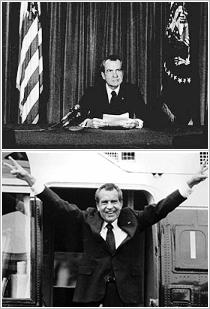Watergate Deniers Whitewashing History at Nixon Library

Back in 2007, the National Archives took over the Richard Nixon Library and Museum in Yorba Linda, California. Among its first tasks in setting the historical record straight regarding the Richard Nixon Foundation's presentation of Watergate as "a 'coup' engineered by Nixon enemies." Now three years later, the Nixon loyalists are back, this time to trying to halt the opening of the new Watergate exhibit scheduled for July 1.
From the moment it opened, the Nixon Library sought to relegate its whitewashed version of history to the fringes. The old Watergate exhibit, as UC Irvine history professor Jon Wiener described it, "was a long dark tunnel that was completely uninviting, block and after block of small panels, white text on a black wall." And what that text said, as the Los Angeles Times reported in 2007, portrayed the Richard Nixon not as a villain, but a victim:
Venturing into that room, visitors learned that Watergate, which provoked a constitutional crisis and became an enduring byword for abuses of executive power, was really a "coup" engineered by Nixon enemies. The exhibit accused Washington Post reporters Bob Woodward and Carl Bernstein -- without evidence -- of "offering bribes" to further their famous coverage.
Most conspicuous was a heavily edited, innocent-seeming version of the "smoking gun" tape of June 23, 1972, the resignation-clinching piece of evidence in which Nixon and his top aide are heard conspiring to thwart the FBI probe of Watergate.
As the Washington Post noted at the time, the presentation of the Nixon tapes themselves was a fraud:
The museum also told visitors that the infamous 18 1/2 -minute gap in one important White House tape -- a conversation three days after the break-in -- was because of a mechanical malfunction.
"No serious historian believes in that," said David Greenberg, a Nixon scholar at Rutgers University. "It's the opposite of truth. There was a lot along those lines in the library, which was not a matter of interpretation, but was flat wrong, a lie."
From the beginning, the conservative project to invent a bogus hagiography of their fallen hero was aided and abetted by some of the leading names in today's right-wing media complex. Monica Crowley, future Fox News regular and plagiarist, was Richard Nixon's one-time editorial adviser and research consultant. And the Nixon Library's first director, right-wing radio host Hugh Hewitt, like his idol tried to stonewall the truth:
Yet from the start, the library had trouble being taken seriously. Its first director, Hugh Hewitt, announced that researchers deemed unfriendly would be banned from the archives, singling out the Washington Post's Bob Woodward as a candidate for exclusion. Scholars cried foul; Hewitt revoked the plan.
What's more, the library possessed only Nixon's pre- and post-presidential papers. In 1974, Congress mandated that his White House materials be kept in the Washington area, amid fears that Watergate-related documents would be destroyed.
Now, as the New York Times reported today, "the exhibit was nearly empty, dominated by a 30-foot blank slate of a wall that is testimony to a new battle set off by this still-polarizing former president: how to mark the scandal that forced him from office 36 years ago." As Timothy Naftali, the current director of the museum, put it, "It is the last fight over Watergate."
And what a fight it is. Backed by the Nixon Foundation, former Tricky Dick aide Bob Bostock filed a 132-page letter of objection to the archives last week. The crux of his complaint about the new exhibit telling the truth is as old as the Watergate scandal itself:
"Taping and wiretapping go back as far as F.D.R.," Mr. Bostock said. "It lacks the context it needs: that Nixon was not the first president to do some of these things and that some of these things had been going on with many of his predecessors, in some cases, much more than he did."
Mercifully, the National Archives, and not the Nixon Foundation, has the final say and will issue a ruling within weeks.
As it turns out, the Museum's old dark tunnel representing the Watergate scandal was altogether fitting of the character of the man who perpetrated it. As Robert F. Kennedy famously put it, "Richard Nixon represents the dark side of the American spirit." But it was Nixon himself who with his parting words to his White House staff on August 9, 1974 best summed up himself - and his faithful loyalists:
Always give your best, never get discouraged, never be petty; always remember, others may hate you, but those who hate you don't win unless you hate them, and then you destroy yourself.

